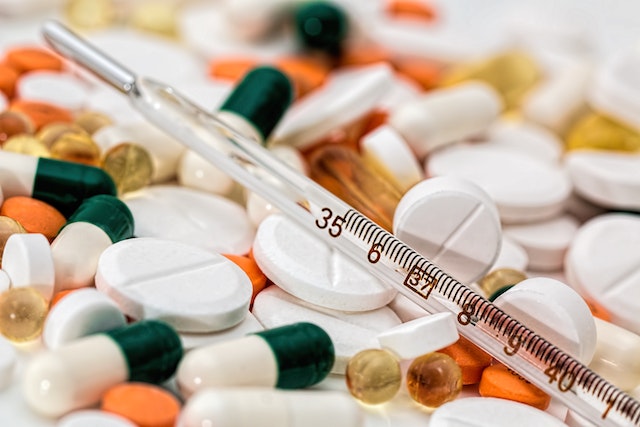
How does antibiotic resistance happen? Bacteria develop the ability to survive an antibiotic, which is then passed on to future generations.
The antibacterial power of some moulds has been known about since 1874, possibly even earlier. In 1897, Ernest Duchesne published a paper about the ability of moulds to kill bacteria. Alexander Fleming noticed that the presence of a certain mould on a culture plate stopped the growth of a bacteria. The first penicillin antibiotic had been synthesized by 1942, but it took the enormous research resources of the Second World War to mass-produce it. Penicillin and other antibiotics became available to the general public from about 1950 onwards. When we are infected with bacteria, they produce toxins and chemicals that harm us and can kill us. This new wonderdrug saved many lives.
So, how do antibiotics kill bacteria? There are two types of antibiotics: broad spectrum, that work on many different bacteria, and narrow spectrum, that work on a specific bacterium. Doctors will choose which antibiotic to give depending on the bacterial infection and different antibiotics work in different ways. Antibiotics stop bacteria in four ways.
The first way is by attacking the wall or the coating surrounding the bacteria. This is how penicillin works. Penicillin stops the bacteria from producing peptidoglycan, which it needs to make its cell walls. Without that, the cell wall fails, and the bacteria dies. Our cells don’t use peptidoglycan, so it doesn’t harm us.
The second way is by interfering with the bacteria’s reproduction. Some antibiotics can target a enzyme called DNA gyrase. Bacteria need this enzyme to uncoil their DNA so that they can replicate it. The antibiotic prevents this and the bacteria cannot reproduce.
The third way is by stopping bacteria from producing folic acid. Our cells can take in folic acid from the food that we eat. Bacteria cannot absorb it and have to produce it themselves. Some antibiotics interfere with the enzyme that bacteria need to produce folic acid and without it they die.
The fourth way is by preventing the bacteria from synthesizing protein. All cells need proteins, and some antibiotics can build up in a bacterium and shut off the protein chains. Without the protein, the cells cannot do anything, and they die.
So, how does antibiotic resistance happen? Antibiotic resistance is a perfect example of evolution. Antibiotics kill most bacteria, most of the time. However, occasionally, there will be a bacterium that accidentally has a mutation that allows it to survive whatever method the antibiotic is using to kill it. All of the unmutated bacteria die, but the new version survives and it reproduces, passing on its mutation. Et voila, a new strain of bacteria that is immune to the antibiotic.
Here are some examples. Gram-negative bacteria have evolved an outer membrane that lets them keep antibiotics out. Pseudomonas aeruginosa bacteria have evolved a pump to remove the antibiotic as it builds up inside them. Klebsiella pneumoniae bacteria have evolved enzymes that break down some antibiotics. Escherichia coli bacteria have evolved a compound on the outside of their cell wall so that antibiotics cannot latch on to them. There are many other examples.
Antibiotic resistance is caused by overusing antibiotics and not using them properly. Some countries and some doctors prescribe antibiotics very quickly. The more often antibiotics are used, the more chances there are for a mutation to occur that makes the bacteria immune. There is a strong selective pressure on the bacteria, making the possibility that mutations will be passed on greater. A lot of poorer countries allow antibiotics to be sold over the counter because many people cannot afford to see a doctor. This only worsens the problem. Also, people don’t use them properly. The course of antibiotics has to be taken to the end and not stopped when a patient starts to feel better. All of the bacteria have to be killed to prevent any of them developing resistance.
Antibiotics were first mass-produced in 1945. That means we have had general access to antibiotics for about 77 years and it is estimated that over 70% of bacteria are currently resistant to the antibiotics that are used to kill them. Many of the major illnesses, such as pneumonia, tuberculosis, blood poisoning, and foodborne diseases are now very hard to cure with antibiotics. 10 million people a year could die because the disease they have is no longer treatable. Many types of surgery that require antibiotics to treat infections afterwards may become impossible to perform.
Some scientists are working on a solution. They have found a way to attach molecules to bacteria that stop the bacteria from producing toxins, without killing it. As it is the toxins that make us sick, not the actual bacteria themselves, this could be a solution. It would be a solution to the antibiotic resistance problem as well because if the bacteria don’t die, there is no strong selective pressure and mutations are less likely to be passed on to the next generation. Hopefully, this will work because if it doesn’t, the human race is in trouble.
So, how does antibiotic resistance happen? Bacteria evolve mutations that let them avoid whatever method the antibiotic is using to kill them. Then they pass this mutation on.
Sources
https://www.yourgenome.org/facts/what-is-antibiotic-resistance/
https://www.cdc.gov/drugresistance/about/how-resistance-happens.html
https://www.who.int/news-room/fact-sheets/detail/antibiotic-resistance
https://en.wikipedia.org/wiki/Antibiotic
https://en.wikipedia.org/wiki/Antimicrobial_resistance
https://www.scientificamerican.com/article/how-do-antibiotics-kill-b/
https://www.medicalnewstoday.com/articles/323388
https://cosmosmagazine.com/science/natural-selection-and-the-pressure-to-evolve/
